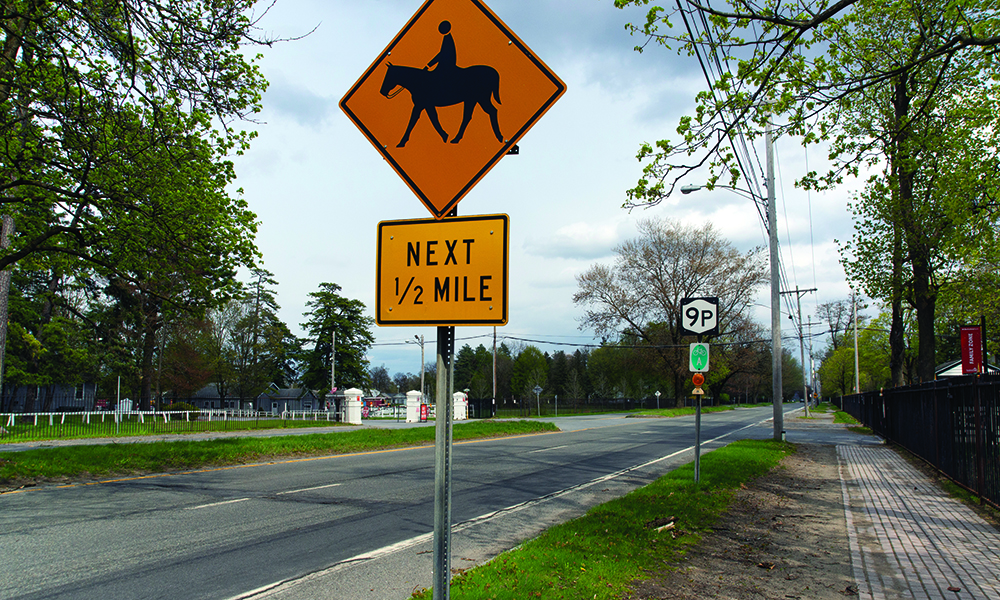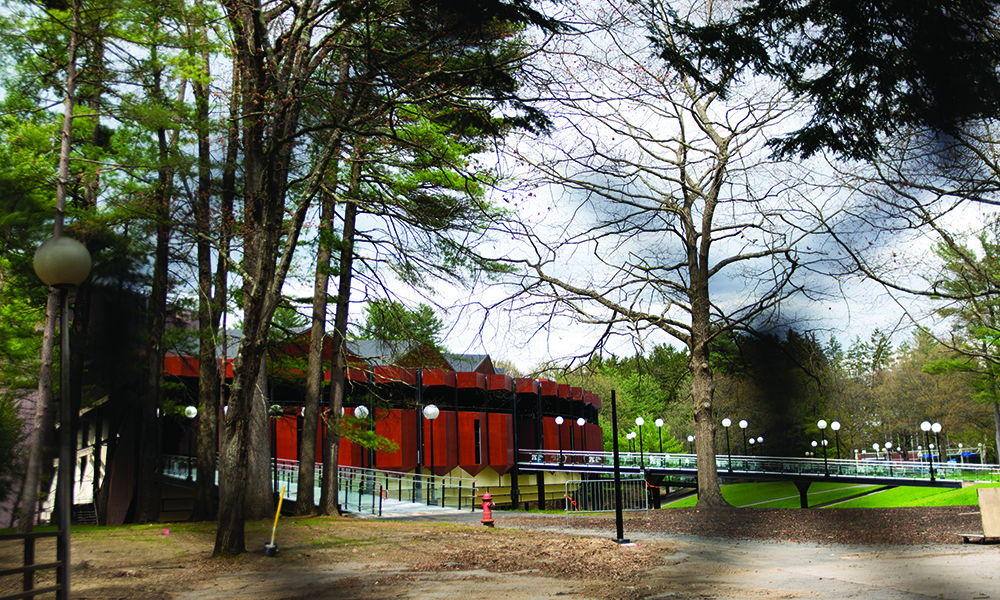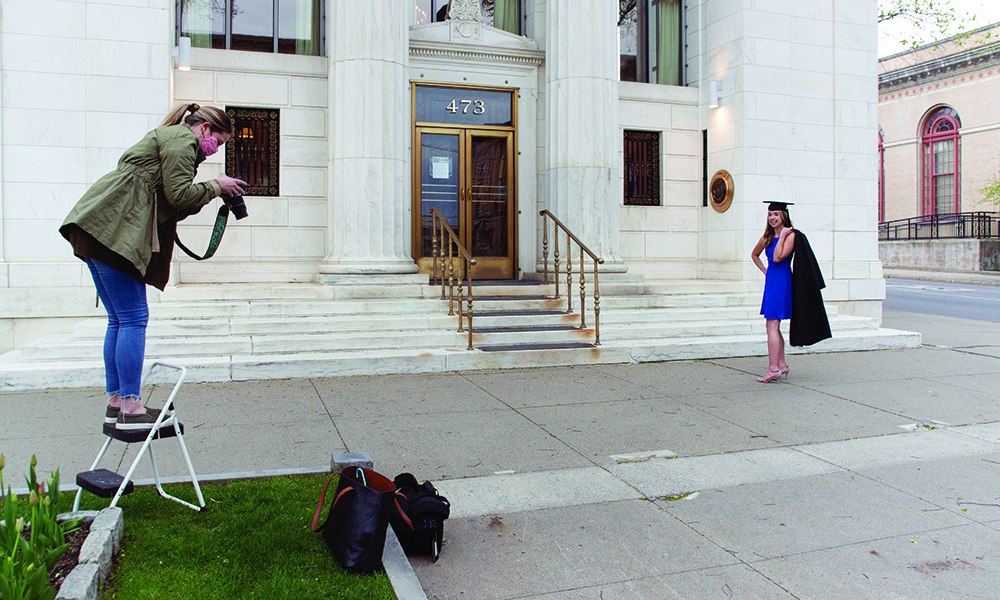It’s hard to believe that we’re nearing the one-year anniversary of the last time Saratoga saw its streets packed with summer visitors on their way to Saratoga Race Course or the Saratoga Performing Arts Center (SPAC). As we write this, the Capital Region is just a week into its first phase of reopening, and so much still remains unknown—especially for Saratoga, whose local economy depends on that annual rush of tourists. But Saratogians aren’t the type to sit around idle, licking their wounds. We’re resilient people; we don’t let tough times get us down—and we’re going to make a Saratoga summer of it, come what may. Here’s how we’ll do it.

Saratoga Race Course
While Governor Andrew Cuomo gave the go-ahead to the state’s horse racing tracks to reopen, sans fans, as early as June 1—Belmont Park’s schedule will begin on the 3rd, with the Belmont Stakes running on the 20th—the New York Racing Association (NYRA), which also runs Saratoga Race Course, hasn’t (as of press time) provided Saratogians with much of a definitive answer on when our track will open, though we know it will likely be fan-less.
Whenever it does open, it’s not going to be total chaos: NYRA has put in place a number of safeguards to keep its employees, participating horsemen and backstretch workers safe. At Belmont, it has started offering voluntary COVID-19 antibody testing for all staffers and backstretch workers, and has put forth a number of health protocols such as mandatory health screenings and temperature checks; policy and workplace adjustments to support strict social distancing; mandatory personal protective measures, including all personnel being required to wear face masks; as well as additional testing and contact tracing. This will all be crucial if NYRA decides to ship its downstate equine party up to Saratoga, even without fans.
And come hell or high water, Saratogians will still be able to enjoy the races, one way or the other. The races will be broadcast on TV and online, and fans will still be able to place wagers, as there are a panoply of smartphone betting apps, such as NYRA Bets, DRF and TwinSpires. “We’re buying a projector that connects to the TV and projecting the races onto the side of the house next door,” says Saratoga resident Maggie Quinn, who lives downtown. “There’s a yard in between, for people to bring chairs to set up six feet apart. Everyone’s already been sitting outside and betting on their apps. We’ll make a special season happen this year, no matter what, even if—especially if—it’s just us locals.”
If bars and restaurants are open by the time Saratoga’s modified track season begins, they could also play host to socially distanced racing fan camaraderie via big-screen TVs or projectors. Caroline Street could be turned into a makeshift Grandstand, and the Adelphi could be a this-summer-only 1863 Club satellite.
And while NYRA’s security will strictly enforce social distancing on the Union Ave. side of the fence, fans will, no doubt, congregate or park along the fence to try to catch a glimpse of a race. Or if you’re lucky enough to own a house along the perimeter of the track—say, on Nelson Avenue—you might be able to get a peek with some high-powered binoculars from your roof. Be careful up there during happy hour, though.

Saratoga Performing Arts Center (SPAC)
The other key piece of Saratoga’s economic/cultural landscape is SPAC. But with its classical season now canceled and the majority of pop acts hosted there by Live Nation having either been nixed completely or postponed until 2021, the focus has shifted to its educational programming and newly launched digital offerings. “We started morphing SPAC’s mission statement last year, because we’d really changed so much in certain fundamental ways,” says Elizabeth Sobol, SPAC’s president and CEO. “We looked at ourselves as no longer just a presenter of great performances on a stage, but a convener of community and education and a protector and steward of the Earth because of our beautiful location.” In just three-and-a-half years, the venue has provided free arts education and experiences to more than 50,000 area students, and early last month, SPAC debuted a new virtual Learning Library, stocked with free educational videos and arts-themed activities.
On top of this, the venue recently announced that it had partnered with Caffè Lena, one of the lone arts venues in the region to have been deemed “essential,” to stage the canceled Saratoga Jazz Fest as an enormously important virtual event to be streamed on the Caffè’s YouTube page June 26-28. “We will be doing more of all of this,” says Sobol. “I can’t say today exactly when, because the river is moving so quickly, but more is definitely coming.”
What could that “more” look like? Of late, there’s been a surge of international interest in drive-in music venues, in which fans watch live, outdoor performances from the comfort and safety of their cars. (Shows are broadcast over the FM radio frequency, and fans can interact with performers via Zoom.) Could SPAC convert its two parking lots, on either side of Route 50, into a COVID-secure music venue? Anything’s possible. Last month, country superstar Keith Urban played a concert to car-bound frontline healthcare workers in an amphitheater in Tennessee.
Or locals could just DIY it. “Because there won’t be any SPAC concerts, which is a thing that my friends and I like to do a lot, I thought we would bring the concert to the backyard,” says Ballston Lake native Molly McCormack. She’s planning on putting on her own Live Nation homage shows on the day they were scheduled to happen at SPAC. For example, on June 6, she’ll host a socially distanced Lumineers concert, where her friends join her to listen to an “opening set” by a band of her choosing, followed by a pre-made Lumineers “set list” on Spotify. There’s even talk amongst her friends, she says, of bringing Oboys from Esperanto and 16-ounce Bud Light cans to make the concerts that much more SPAC authentic.

Downtown Saratoga
Saratoga’s many small businesses, especially along Broadway, bank heavily on the presence of summer tourists from the two aforementioned venues. And while there likely won’t be the usual crush of out-of-towners—Governor Cuomo has warned against too much interstate and intrastate mixing, for fear of upping the infection rate and having to shut things down all over again—there is still hope for a lucrative summer season, powered by us locals, some of whom usually leave town to escape the crowds or make money by renting out our homes.
“We’re usually busiest during the summer, when a lot of people sit outside,” says Tyler Russell, co-owner of Saratoga restaurant Farmers Hardware, which is still temporarily closed to diners but has been doing a steady takeout/to-go business (see Hot Chef, p. 72). “This year, with our brunch boxes, we were busy in April and May, with 100 percent local people supporting us and our community. The takeaway is how strong our community is. We can survive this with just our local community. We’re prepared for our second pivot.” His business partner and wife, Julia Sanzen, echoes his positivity. “After all of this is over,” she says, “we’ll still be here.”
At press time, the Capital Region was already a week into the aforementioned first phase of its reopening—or the return of construction, manufacturing and wholesale supply chain businesses; curbside pickup for retail outlets; and a refresh for agriculture, forestry and fishing. If the phases are spread out over two-week increments, as the governor has estimated, technically, we could be fully reopened by about mid-July—just in time for the fan-less races. (The track was set to open on July 16.) That would mean many of us would be back to work, with social distancing and personal protective equipment protocols in place, throughout the city; restaurants and hotels would have reopened, with similar tweaks in place; and arts, entertainment and recreation venues would have the go-ahead to reopen but likely with major restrictions on crowd sizes. In other words, the economy would be ready to rock.
“What I’m looking forward to is having our city come back to life,” says Saratoga Mayor Meg Kelly. “We need to get the shops open, the restaurants open, we need to see people walking downtown. I just think the vibrancy needs to come back, but we need to do it in the safest way possible.”
In the meantime, downtown businesses that have been forced to temporarily close have gotten creative, with many focusing their energies online. One Spa City-based gift shop and home goods store, Homessence, formerly at 439 Broadway, has completely switched over to online retail—at least for now. “We were there on Broadway for eight years as of March 2020,” says owner Tina DeMartino. “We were doing so well before the pandemic. We were actually doing better than ever.” DeMartino decided to close her storefront location, take photos of her entire inventory and put her shop online at the end of May. But DeMartino’s not planning on staying virtual forever. “I do plan to relocate, but certainly not until things really settle with the economy,” she says. “I do love having a store on Broadway—I love meeting people from all over the country and the world—but without a track season, I don’t see the point of moving forward with a store on Broadway.”
It’s a long shot, but the city could explore turning Broadway into a socially distanced bazaar for portions of the summer, by closing off car and truck traffic between Congress Street and NY-29, for stretches of the afternoon or evening—or the entire season. It would promote safety and health—and above all, business, as restaurants and boutiques could reopen with socially distanced tables and retail racks, respectively, extended out into the street.
We’d do anything to save Saratoga. Wouldn’t you?
